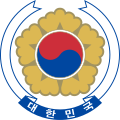National Association (South Korea)
National Association 국민회 國民會 | |
|---|---|
| Founder | Syngman Rhee, Kim Ku |
| Founded | 1946 |
| Dissolved | 1960 |
| Merged into | Liberal Party |
| Headquarters | Seoul, South Korea |
| Ideology | Conservatism (South Korean)[1] |
| Political position | Right-wing[2] to far-right[1] |
| This article is part of a series on |
| Conservatism in South Korea |
|---|
 |
The National Association (Korean: 국민회; Hanja: 國民會) was a political party in South Korea.
History
[edit]Syngman Rhee established the Central Committee for the Rapid Realisation of Korean Independence in October 1945, shortly after he had returned from exile. As a result of widespread opposition to the Moscow Conference, the Committee gained the backing of the leaders of the provisional government and several political parties, including the Korea Democratic Party, the Korean Independence Party and a faction of the Communist Party.[3]
The Communist Party faction later withdrew its support, but the others involved formed the Central Council for the Rapid Realization of Korean Independence (CCRRKI) on 8 February 1946. The new party opposed the proposed trusteeship, but when Rhee called for separate elections to be held in South Korea, President Kim Ku and others left the party. In the 1948 elections it won 55 of the 200 seats, emerging as the largest party.[4]
The party was subsequently renamed the "National Association".[3] In the 1950 elections it was reduced to 14 seats, finishing third behind the Democratic Nationalist Party and the Korea Nationalist Party.[4] In 1951 Rhee established the Liberal Party. However, the National Association remained extant until the end of his presidency in 1960.[3] It won three seats in the 1954 elections, but lost parliamentary representation in the 1958 elections.
Election results
[edit]President
[edit]| Election | Candidate | Votes | % | Result |
|---|---|---|---|---|
| 1948 | Syngman Rhee | 180 | 92.31 | Elected |
| 1956 | 5,046,437 | 69.99 | Elected | |
| 1960 | 9,633,376 | 100 | Elected |
Vice-President
[edit]| Election | Candidate | First round | Second round | Result | ||
|---|---|---|---|---|---|---|
| Votes | % | Votes | % | |||
| 1948 | Yi Si-yeong | 113 | 57.36 | 133 | 67.86 | Elected |
Constitutional Assembly
[edit]| Election | Leader | Votes | % | Seats | Status |
|---|---|---|---|---|---|
| 1948 | Syngman Rhee | 1,755,543 | 25.87 | 55 / 200 | Government |
House of Representatives
[edit]| Election | Leader | Votes | % | Seats | +/– | Position | Status |
|---|---|---|---|---|---|---|---|
| 1950 | Syngman Rhee | 473,153 | 6.77 | 14 / 210 | new | 3rd | Opposition |
| 1954 | 192,109 | 2.56 | 3 / 203 | Opposition | |||
| 1958 | 50,568 | 0.59 | 0 / 233 | 4th | Extra-parliamentary |
References
[edit]- ^ a b 길승흠, ed. (1996). 한국정치연구 (Journal of Korean Politics) Vol. 5: 제 1공화국의 정당과 의회정치. Seoul National University's Institute of Korean Political Studies. p. 121.
이어서 이승만 박사는 국민회와 한민당 세력의 지원으로 제헌국회에서 대통령으로 당선되고, 8월 15일 정부수립을 공포함으로써 제1공화국을 출범시켰던 것이다. 다시 말하면, 한국의 제1공화국은 극우 보수세력을 중심으로 출범하였던 것이다.
- ^ Yves Beigbeder, ed. (2021). International Monitoring of Plebiscites, Referenda and National Elections: Self-Determination and Transition to Democracy. BRILL. p. 123.
- ^ a b c Haruhiro Fukui (1985) Political parties of Asia and the Pacific, Greenwood Press, pp674–675
- ^ a b Dieter Nohlen, Florian Grotz & Christof Hartmann (2001) Elections in Asia: A data handbook, Volume II, p428 ISBN 0-19-924959-8


 French
French Deutsch
Deutsch